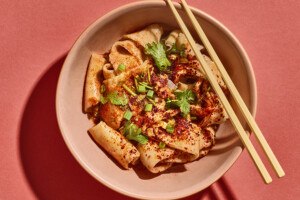The Definitive Guide to Eating in Chinatown
From Hong Kong-style Cantonese seafood at Peach Farm to surf-and-turf hot pot at Kaze Shabu Shabu—these are the best spots to eat and drink in Chinatown right now.

Diners tuck into malatang (Sichuan skewer pot) at the aptly named Spicy World. / Toan Trinh
Much like the Italian-oriented North End, this tight-knit neighborhood is so jam-packed with restaurants—many offering variations on similar cuisines and themes—that it’s hard for the uninitiated to know where to stop and what to skip. Behold our highly subjective guide to Chinatown’s best, a primer on superlative spots that covers every base, from Beijing-style street snacks to Cantonese barbecue.
CHINA KING
There are two main reasons to dine at China King: Peking duck and owner Doris Huang. The perfect poultry (which must be ordered 24 hours in advance) is rubbed with maltose, hung overnight, roasted, and served in three courses—crisp duck skin with homemade flour pancakes and hoisin sauce; stir-fried duck with vegetables or noodles; and, finally, duck soup. Huang, meanwhile, is one of those natural hosts whose megawatt personality defines her restaurant.
60 Beach St., 617-542-1763, chinakingma.com.
EMPIRE GARDEN RESTAURANT
Are you in Shanghai? Hong Kong? Taipei? Thanks to an impressive recent renovation and lots of gold paint, it’s easy to feel transported when you walk into this cavernous dim sum palace, located on the mezzanine level of a turn-of-the-century vaudeville theater. Don’t let the carts pass by without grabbing a plate of baked pork buns, glistening with sticky-sweet glaze; rice-paper-wrapped shrimp har gow dumplings; or tender ginger tripe.
690 Washington St., 617-482-8898, empiregardenboston.com.
Taiwan Café’s Peter Wang shares his top take-home goodies.
1. LIVE BLACK SEA BASS, HAPPY FAMILY FOOD MARKET
“They sell some of the best and freshest live fish you can find anywhere. You can see for yourself how healthy they are in the tanks when you choose them. I particularly like the black sea bass. I steam or pan-fry them, depending on my mood.”11A Hudson St., 617-542-1488.2. LEE KUM KEE OYSTER SAUCE, JIA HO MARKET
“I’ve used this top-grade oyster sauce for as long as I can remember. It’s very rich and it helps elevate my favorite dishes to the next level. This pairs great with a variety of fresh seasonal fish and vegetables.”692 Washington St., 617-338-9788.3. HERBAL BALM (CHING WAN HUNG), NAM BAC HONG
“This balm treatment is something everyone should have as part of their first-aid kit and always keep in the kitchen. It’s a great Chinese remedy for soothing pain, as it heals burns fast. They tend to disappear in the restaurant’s kitchens, so I find myself stocking up often!”75 Harrison Ave., 617-426-8227.
4. CHICKEN, MING KEE LIVE POULTRY
“They sell freshly butchered chicken; you can even pick the live chicken you want. This chicken is so flavorful, it tastes nothing like what you get at a regular grocery store in Boston.”
54 Kneeland St., 617-482-3618.
HONG KONG EATERY
At Hong Kong Eatery, everyone slurps on bowls of soup showcasing (hands down) the best wontons in Chinatown, stuffed with pork and fish, then poached in boiling water and served in savory broth with a sprinkle of scallion greens. Enjoy the soup with a side of Cantonese barbecue—your choice of roasted chicken, crispy pork, or more—appetizingly displayed in the front window before it’s cut into chopsticks-friendly pieces.
79 Harrison Ave., 617-423-0838, hongkongeatery.com.
KAZE SHABU SHABU
What makes Kaze Shabu Shabu our go-to hot-pot destination in Chinatown? It’s the mo’ choices, mo’ fun approach to dining—including 13 broths, two noodles, and dozens of cool ingredients to help you personalize your pot (think: house-made fish, shrimp, or cuttlefish pastes and Australian or Japanese Kobe beef). Order the surf-and-turf combo with sides of quail egg and veal tongue, flip on the in-table ceramic induction burner, and get cookin’.
One Harrison Ave., 617- 338-8283, kazeshabu.com.
NEW DONG KHANH
Unfortunately, New Dong Khanh closed for good in August 2019.
If you’re looking for a change of pace from pho, New Dong Khanh’s tamarind-scented cahn chua—a light sweet-and-sour soup from the Mekong region of southern Vietnam that substitutes bean sprouts for noodles—is equally satisfying and full-flavored. The kitchen also does an excellent job with Vietnamese favorites such as fresh spring rolls, ground-shrimp-wrapped sugar cane, and banh xeo, a rice flour–coconut milk crêpe commonly called Vietnamese “pizza” (though there’s nothing particularly pizza-like about it) that’s folded over pork and shrimp.
83 Harrison Ave., 617-426-9410, newdongkhanh.com.
NEW SHANGHAI RESTAURANT
Unfortunately, New Shanghai closed for good in May 2019.
The name is a bit misleading, as New Shanghai is actually the place for Sichuan food and Beijing-style snacks in Chinatown. Ask co-owner Frank Xing to guide you through the extensive menu, which includes fried cumin lamb and ma po tofu covered with chili oil and ground Sichuan peppercorns for a camphoric one-two punch. Word to the wise: Cubed cucumbers bathed in emerald-green scallion sauce are ideal for cooling the palate after a particularly spicy repast.
21 Hudson St., 617-338-6688, newshanghaiboston.com.
PENANG
Malaysian fare is a mash-up of Chinese, Indian, Thai, and indigenous cuisines that celebrates spicy, salty, and sweet flavors and contrasting textures. At Penang, enjoy Malaysian staples like roti canai, a flaky crêpe you dunk into curried chicken gravy, and beef rendang, beef stewed in cinnamon-and-clove-scented coconut milk. The pine-beamed, jungle-hut décor, meanwhile, evokes warmer climes and demands a durian shake—and perhaps a cold beer or two.
685 Washington St., 617-451-6373, penangmalaysian.com.
PEACH FARM
Choose your dinner from the tank by the front door for some of the best Hong Kong–style Cantonese seafood in Chinatown—or, dare we say, anywhere. A deep dive into the ocean’s bounty starts with chef Andy Yang’s outstanding steamed whole black fish with ginger and soy (seasonally available), continues with scallops on the half shell garnished with minced garlic, and ends with clams in black-bean sauce strewn with slivered green chilies.
4 Tyler St., 617-482-3332, peachfarmboston.com.
SHŌJŌ
Owner Brian Moy’s Shōjō has been paving a path for the Chinatown of today and tomorrow, continuing a family restaurant legacy that started upstairs at China Pearl, which his family purchased in 1988. Come for the Thai-chili-infused vodka and 12 year-old Yamazaki, stay for modern fusion fare like cashew-shrimp bao and chicken and waffles with five-spice butter. The colorful street-art-style mural on the rear wall is repainted annually, a not-so-subtle message that new growth brings exciting evolution—to both restaurants and neighborhoods.
9A Tyler St., 617-423-7888, shojoboston.com.
SPICY WORLD
Spicy World was among the first restaurants to bring malatang (Sichuan skewer pot) dining to Massachusetts—think hot-pot dining with none of the DIY work. Here, you choose your broth’s spice level ($2.50), decide on skewers of meats and veggies (from lotus root to lamb, $1 each), and pick a starch ($1.50-$3). Then discover for yourself why malatang is such a popular street snack in Beijing.
7 Beach St., 617-654-2980, spicyworldboston.com.
More Chinatown Dining
SWEET
The Best Pastries in Chinatown Right Now »
LATE-NIGHT BUZZ
Where to Eat (And Drink) in Chinatown After Hours »
DIM SUM FOR DUMMIES
How to Navigate the Dim Sum Cart at Chinatown’s Oldest Restaurant »
This story is part of The Ultimate Guide to Chinatown, from the February 2019 issue of Boston magazine.


